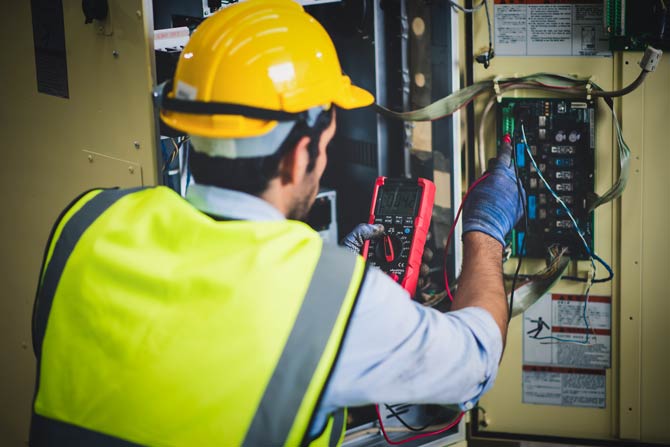
Employers in Germany are obliged to ensure the safest possible working conditions. This is intended to prevent accidents at work and thus improve the health and well-being of employees. In addition, the employers themselves benefit – through less absenteeism. In addition, this measure can prevent conflicts with the workforce, which often occur with low risk prevention. One measure in this area is the DGUV V3 test.
However, many entrepreneurs do not know exactly what this is and what regulations there are in this regard. This article is intended to answer all questions about the DGUV V3 exam.
Prevent hazards when handling electrical equipment
The DGUV V3 test serves to prevent hazards when handling electrical equipment. Although electricity is an indispensable source of energy in almost all companies, its use is associated with certain risks.
If a worker comes into contact with an electrical conductor, they will receive an electric shock, which can be dangerous.
In addition, short circuits can cause fires. This also poses a significant risk to employees. These dangers are significantly higher in commercial establishments than in private households, since devices that work with very high currents and voltages are often used here. However, it is possible to reduce the risks. If the electrical equipment has good insulation and intact protective conductors, the probability of an accident is low.
However, since the corresponding protective measures can lose their effectiveness over time, regular checks are very important.

What is the DGUV V3 exam?
The last paragraph showed the dangers that electrical equipment can pose. However, it is possible to reduce this with regular testing. In order to design a uniform procedure for this, the German Social Accident Insurance (DGUV) has drawn up a corresponding set of rules.
Regulation 3 – abbreviated as DGUV V3 – deals with the specifications for electrical safety.
For which equipment is the DGUV V3 necessary?
The DGUV V3 is required for all systems and devices that are connected to the public power grid. On the one hand, this applies to the permanently installed systems in the building. This includes sockets, light switches, cables and fuse boxes. In addition, the test is required for all permanently installed, electrically operated machines.
It is also very important to ensure that the DGUV V3 also includes small, portable devices such as drills, computers or printers.
The DGUV V3 test is even required for devices that are actually not required for the work – such as the coffee machine in the lounge.

Is the DGUV V3 test mandatory?
In many companies, the question arises as to whether the DGUV V3 test is required by law – after all, accident insurance is not a legislative body. Nevertheless, this electrical test is mandatory. This is derived from the Occupational Health and Safety Act. The DGUV is merely the body that sets the relevant rules. If a company does not have this test carried out, it must expect considerable fines. Deliberate non-compliance can even constitute a criminal offence.
There is also another problem: If the employer did not have the DGUV V3 test carried out, there is no insurance cover. In the event of an accident at work, he is therefore liable.
What deadlines must be paid attention to?
In principle, the DGUV V3 test is required before the electrical installations and devices are put into operation. With many portable devices, however, this task is already taken on by the manufacturer. In this case, a new test before commissioning is not necessary – provided that the corresponding test report is available. It is also important to note that this is a recurring test.
However, how long the intervals are depends on the type of equipment and an individual risk assessment.
The inspector must therefore always note in the test log when the next inspection is required. The periods are usually between six months and two years.
Carrying out the electrical test
In order to carry out the electrical test in accordance with the rules, it is necessary to ensure that the procedure is correct. It is also important to draw up a test report and to ensure that the testers are sufficiently qualified.

Which standards have to be observed?
The exact specifications for carrying out the DGUV V3 test are not included in this regulation. For this purpose, it refers to various standards of the Association for Electrical, Electronic & Information Technologies (VDE). These contain detailed specifications for carrying out the test. Different VDE standards must be taken into account here – depending on the type of equipment involved and whether you are carrying out an initial test or a repeat test.
In most cases, however, a visual inspection is required first to detect obvious damage or improper use.
After that, it is important to measure various safety-related characteristics – such as the protective conductor resistance or the insulation resistance. Finally, in most cases, a functional test takes place.
The test log
After the examination, the examiner must create a protocol. It notes whether the relevant equipment passed the test and whether there are any defects.
Finally, it must state when the next test is required.

Who is allowed to carry out the DGUV V3 test?
The examiners must have completed vocational training in the field of electrical engineering and have several years of professional experience. In addition, the Technical Rules for Operational Safety (TRBS) specify a number of other requirements.
It is not mandatory that it is an external auditor. However, since an external service provider also assumes liability, this is always recommended – even if there is a worker with the appropriate qualifications in your company.
Choosing a professional provider is important for the DGUV V3 exam
A strong partner for the DGUV V3 test not only guarantees legally compliant implementation.
In addition, you benefit from careful planning and fast implementation. In this way, the measure affects your production processes as little as possible.
Source: https://www.blog.de/arbeitssicherheit-im-elektrischen-bereich/


